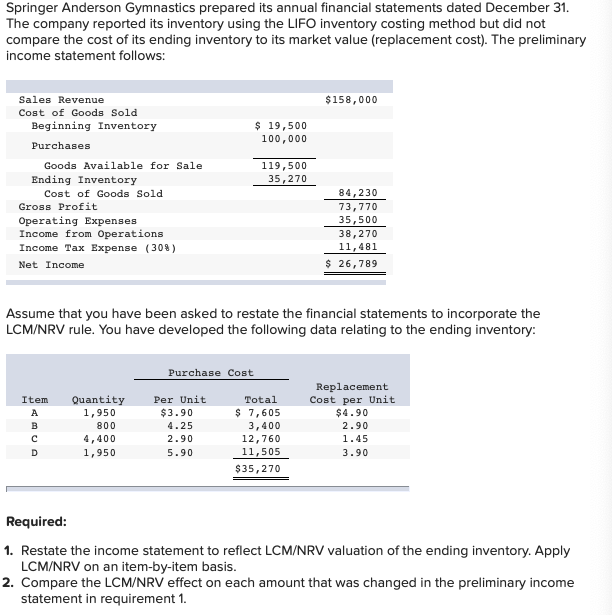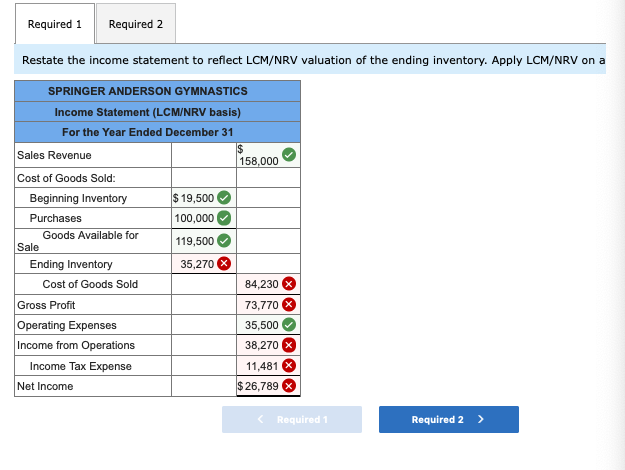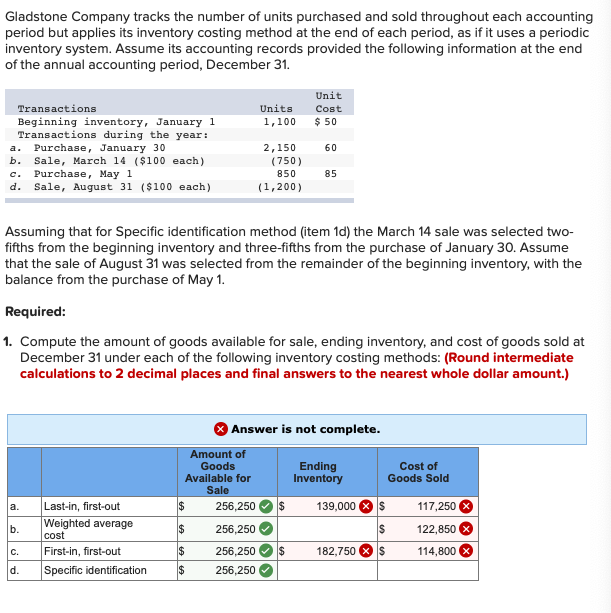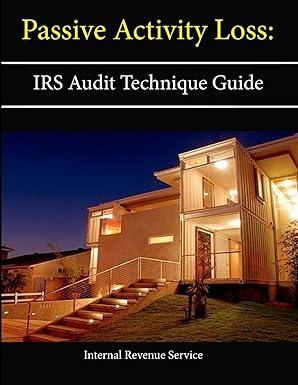


Springer Anderson Gymnastics prepared its annual financial statements dated December 31. The company reported its inventory using the LIFO inventory costing method but did not compare the cost of its ending inventory to its market value (replacement cost). The preliminary income statement follows: $ 158,000 $ 19,500 100,000 Sales Revenue Cost of Goods Sold Beginning Inventory Purchases Goods Available for Sale Ending Inventory Cost of Goods Sold Gross Profit Operating Expenses Income from Operations Income Tax Expense (30%) Net Income 119,500 35,270 84,230 73, 770 35,500 38,270 11,481 $ 26,789 Assume that you have been asked to restate the financial statements to incorporate the LCM/NRV rule. You have developed the following data relating to the ending inventory: Purchase Cost Item A B Quantity 1,950 800 4,400 1,950 Per Unit $3.90 4.25 2.90 5.90 Total $ 7,605 3,400 12,760 11,505 $35,270 Replacement Cost per Unit $4.90 2.90 1.45 3.90 D Required: 1. Restate the income statement to reflect LCM/NRV valuation of the ending inventory. Apply LCM/NRV on an item-by-item basis. 2. Compare the LCM/NRV effect on each amount that was changed in the preliminary income statement in requirement 1. Required 1 Required 2 Restate the income statement to reflect LCM/NRV valuation of the ending inventory. Apply LCM/NRV on a SPRINGER ANDERSON GYMNASTICS Income Statement (LCM/NRV basis) For the Year Ended December 31 $ Sales Revenue 158,000 Cost of Goods Sold: Beginning Inventory $ 19,500 Purchases 100,000 Goods Available for 119,500 Sale Ending Inventory 35,270 Cost of Goods Sold 84,230 Gross Profit 73,770 Operating Expenses 35,500 Income from Operations 38,270 Income Tax Expense 11,481 Net Income $ 26,789 Gladstone Company tracks the number of units purchased and sold throughout each accounting period but applies its inventory costing method at the end of each period, as if it uses a periodic inventory system. Assume its accounting records provided the following information at the end of the annual accounting period, December 31. Units 1,100 Unit Cost $ 50 Transactions Beginning inventory, January 1 Transactions during the year : a. Purchase, January 30 b. Sale, March 14 ($100 each) Purchase, May 1 d. Sale, August 31 ($100 each) 60 2,150 (750) 850 (1,200) 85 Assuming that for Specific identification method (item 1d) the March 14 sale was selected two- fifths from the beginning inventory and three-fifths from the purchase of January 30. Assume that the sale of August 31 was selected from the remainder of the beginning inventory, with the balance from the purchase of May 1. Required: 1. Compute the amount of goods available for sale, ending inventory, and cost of goods sold at December 31 under each of the following inventory costing methods: (Round intermediate calculations to 2 decimal places and final answers to the nearest whole dollar amount.) Answer is not complete. Amount of Goods Ending Cost of Available for Inventory Goods Sold Sale $ 256,250 139,000 $ 117,250 $ 256,250 122,850 $ 256,250 $ 182,750 s 114,800 $ 256,250 a. b. Last-in, first-out Weighted average cost First-in, first-out Specific identification C. d









